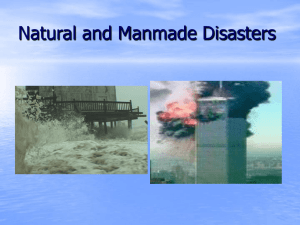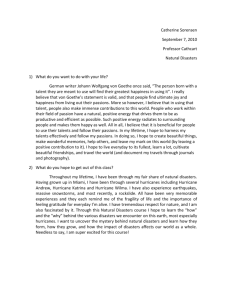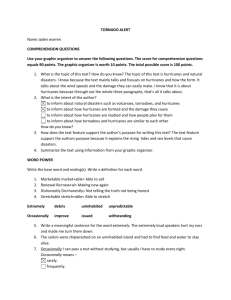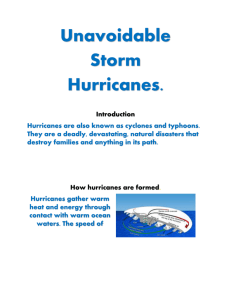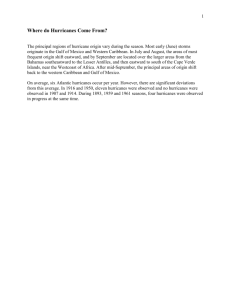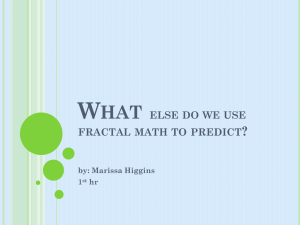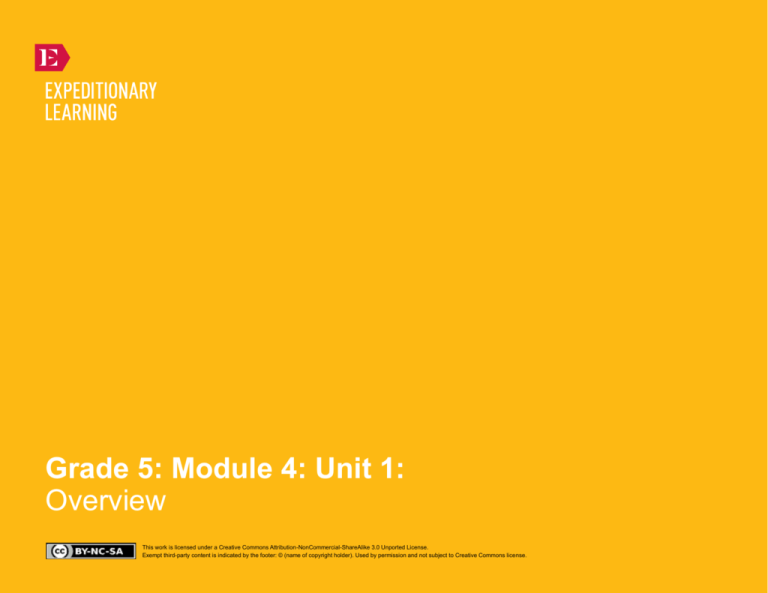
Grade 5: Module 4: Unit 1:
Overview
This work is licensed under a Creative Commons Attribution-NonCommercial-ShareAlike 3.0 Unported License.
Exempt third-party content is indicated by the footer: © (name of copyright holder). Used by permission and not subject to Creative Commons license.
GRADE 5: MODULE 4: UNIT 1: OVERVIEW
Building Background Knowledge:
The Science behind Natural Disasters
Unit 1: Building Background Knowledge: The Science Behind Natural Disasters
In this very short unit, students will build their background knowledge about the
science behind natural disasters. They will read two informational articles, one
about hurricanes and the other about earthquakes. Students will focus on the
relationships between scientific concepts in these informational texts, specifically
how hurricanes and earthquakes form and what happens when they occur. For the
mid-unit assessment, students will read and answer text-dependent questions
about one new informational text about hurricanes. Following the mid-unit
assessment, students will be read another new informational text, this one about
earthquakes. They will then synthesize the information from both informational
texts about hurricanes and earthquakes and organize their ideas in preparation for
the end of unit assessment. For the end of unit on-demand assessment, students
write an essay in which they explain how a hurricane is a natural disaster as well as
participate in a Science Talk with peers about natural disasters. Students cite and
organize evidence from multiple texts on the same topic.
Guiding Questions And Big Ideas
• What is a natural disaster?
• Extreme natural events can have positive and negative effects on the environment and humans.
Mid-Unit 1 Assessment
Text-Dependent Short-Answer Quiz—The Effects of Natural Disasters
This assessment centers on NYSP12 ELA Standards RI.5.1, RI.5.3, and RI.5.4. After reading one new text on hurricanes,
students will answer text-dependent multiple-choice and short-answer questions that assess their knowledge of how the
formation of hurricanes is a causal relationship. They will also be expected to use strategies for finding the meaning of
academic and scientific vocabulary in context (a skill they have been practicing all year).
End of Unit 1 Assessment
On-Demand Essay “What Makes a Hurricane a Natural Disaster?”
This assessment has two parts. Part 1 of this assessment is an essay that centers on NYSP12 ELA CCLS W.5.2, W.5.4, and
W.5.9b. Part 2 of this assessment is a Science Talk that centers on NYSP12 ELA CCLS SL.5.1a, b, c, d, and f. After reading two
articles on hurricanes, students will write an essay that answers the prompt “What makes a hurricane a natural disaster?”
Students will be expected to support their discussion with evidence from the text(s). They will write a well-developed
explanatory essay that contains a topic statement, two body paragraphs, and a concluding statement. In Part 2, students will
prepare for and participate in a Science Talk in which they discuss with peers what a natural disaster is.
Copyright © 2013 by Expeditionary Learning, New York, NY. All Rights Reserved.
NYS Common Core ELA Curriculum • G5:M4:U1: Overview • June 2014
•
1
GRADE 5: MODULE 4: UNIT 1: OVERVIEW
Building Background Knowledge:
The Science behind Natural Disasters
Content Connections
This module is designed to address English Language Arts standards. However, the module intentionally incorporates Social Studies and Science content that many
teachers may be teaching during other parts of the day. These intentional connections are described below.
Big ideas and guiding questions are informed by the New York State Common Core K-8 Social Studies Framework:
http://engageny.org/sites/default/files/resource/attachments/ss-framework-k-8.pdf
NYS Social Studies Core Curriculum:
• 2.1e Extreme natural events (floods, fires, earthquakes, volcanic eruptions, hurricanes, tornadoes, and other severe storms) may have positive or negative impacts on
living things.
• 5.2g The health, growth, and development of organisms are affected by environmental conditions such as the availability of food, air, water, space, shelter, heat, and
sunlight.
Texts
1. "Earthquake." The New Book of Knowledge. Grolier Online, 2013. Web.
2. ”How Does a Hurricane Form?” as found at http://scijinks.nasa.gov/hurricane
3. Carr, Karen. "Earthquakes." Kidipede. Kidipede.com, Web. <http://scienceforkids.kidipede.com/geology/earthquakes/>.
4. "Hurricanes." Hurricanes. University Corporation for Atmospheric Research, n.d. Web.
Copyright © 2013 by Expeditionary Learning, New York, NY. All Rights Reserved.
NYS Common Core ELA Curriculum • G5:M4:U1: Overview • June 2014
•
2
GRADE 5: MODULE 4: UNIT 1: OVERVIEW
Unit-at-a-Glance
This unit is approximately 1.5 weeks or 8 sessions of instruction.
Lesson
Lesson Title
Long-Term Targets
Supporting Targets
Lesson 1
Building Background Knowledge
and Making Inferences: What Is
a Natural Disaster?
• I can make inferences using quotes
from the text. (RI.5.1)
• I can make inferences about natural
disasters based on information from
texts.
• I can accurately synthesize information
from multiple texts on the same topic.
(RI.5.9)
• I can draw conclusions about natural
disasters following a discussion.
Ongoing
Assessment
Anchor Charts &
Protocols
• Journal (What Do We Know
About Natural Disasters,
Hurricanes, and
Earthquakes anchor charts,
glossaries)
• What Do We Know about
Natural Disasters?
• I can effectively engage in discussions
with diverse partners about fifth-grade
topics and texts. (SL.5.1)
Lesson 2
Relationships Between Key
Scientific Concepts: What Causes
Earthquakes?
• I can explain what a text says using
quotes from the text. (RI.5.1)
• I can explain important relationships
between people, events, and ideas in a
historical, scientific, or technical text
using specific details in the text.
(RI.5.3)
• Gallery Walk protocol
• World Café protocol
• Hurricanes
• Earthquakes
• I can explain the relationship between
scientific concepts about earthquakes
using specific details from the text.
• I can use context clues to determine the
meaning of new words in an article
about earthquakes.
• Annotated “Earthquakes”
article
• Give One, Get One, Move
On protocol
• Earthquake Concepts notecatcher
• What Do We Know about
Natural Disasters?
• Glossaries (scientific and
academic vocabulary)
• Vocabulary Strategies
• Earthquakes
• I can determine the meaning of
academic words or phrases in an
informational text. (RI.5.4)
• I can determine the meaning of
content words or phrases in an
informational text. (RI.5.4)
Copyright © 2013 by Expeditionary Learning, New York, NY. All Rights Reserved.
NYS Common Core ELA Curriculum • G5:M4:U1: Overview • June 2014
•
3
GRADE 5: MODULE 4: UNIT 1: OVERVIEW
Unit-at-a-Glance
Lesson
Lesson Title
Long-Term Targets
Supporting Targets
Lesson 3
Relationships Between Key
Scientific Concepts: What Causes
Hurricanes?
• I can explain what a text says using
quotes from the text. (RI.5.1)
• I can explain the relationship between
scientific concepts about hurricanes
using specific details from the text.
• I can explain important relationships
between people, events, and ideas in a
historical, scientific, or technical text
using specific details in the text.
(RI.5.3)
• I can use context clues to determine the
meaning of new words in an article
about hurricanes.
Ongoing
Assessment
Anchor Charts &
Protocols
• Annotated “Hurricanes”
article
• What Do We Know about
Natural Disasters?
• Hurricane Concepts notecatcher
• Vocabulary Strategies
• Hurricanes
• Glossaries (scientific and
academic vocabulary)
• I can determine the meaning of
academic words or phrases in an
informational text. (RI.5.4)
• I can determine the meaning of
content words or phrases in an
informational text. (RI.5.4)
Lesson 4
Mid-Unit Assessment: TextDependent Short-Answer Quiz—
The Effects of Natural Disasters
• I can explain what a text says using
quotes from the text. (RI.5.1)
• I can explain important relationships
between people, events, and ideas in a
historical, scientific, or technical text
using specific details in the text.
(RI.5.3)
• I can determine the meaning of
academic words or phrases in an
informational text. (RI.5.4)
• I can explain the relationship between
scientific concepts about earthquakes
and hurricanes using specific details
from text.
• Mid-Unit 1 Assessment
• Things Close Readers Do
• Mid-Unit 1 Assessment:
Tracking My Progress
• What Do We Know about
Natural Disasters?
• I can determine the meaning of new
words from context about natural
disasters.
• I can reflect on my learning.
• I can determine the meaning of
content words or phrases in an
informational text. (RI.5.4)
Copyright © 2013 by Expeditionary Learning, New York, NY. All Rights Reserved.
NYS Common Core ELA Curriculum • G5:M4:U1: Overview • June 2014
•
4
GRADE 5: MODULE 4: UNIT 1: OVERVIEW
Unit-at-a-Glance
Lesson
Lesson Title
Long-Term Targets
Supporting Targets
Ongoing
Assessment
Anchor Charts &
Protocols
Lesson 5
Synthesizing Information from
Texts about Natural Disasters:
What Makes an Earthquake a
Natural Disaster?
• I can explain what a text says using
quotes from the text. (RI.5.1)
• I can synthesize information about
earthquakes and hurricanes using
details from several texts.
• Journal (Earthquakes and
Hurricanes note-catchers,
glossaries)
• Back-to-Back, Face-to-Face
protocol
• I can determine the meaning of new
words about earthquakes and
hurricanes through context.
• Earthquake Concepts notecatcher (begun in Lesson 2,
added to in Lesson 4
homework)
• Hurricanes
• I can determine the meaning of
academic words or phrases in an
informational text. (RI.5.4)
• I can determine the meaning of
content words or phrases in an
informational text. (RI.5.4)
Organizing Evidence from
Multiple Informational Texts to
Prepare for Writing: What Makes
an Earthquake a Natural
Disaster?
• I can write informative/explanatory
texts that convey ideas and
information clearly. (W.5.2)
• I can group supporting details together
about how earthquakes and hurricanes
are a natural disaster.
• I can produce clear and coherent
writing that is appropriate to task,
purpose, and audience. (W.5.4)
• I can develop the topic with details and
quotes from the texts.
• I can choose evidence from literary or
informational texts to support
analysis, reflection, and research.
(W.5.9)
Copyright © 2013 by Expeditionary Learning, New York, NY. All Rights Reserved.
• What Do We Know about
Natural Disasters?
• Hurricane Concepts notecatcher (begun in Lesson 3,
added to in Lesson 4
homework)
• I can accurately synthesize information
from multiple texts on the same topic.
(RI.5.9)
Lesson 6
• Vocabulary Strategies
• Journal (glossaries)
• Writing about Hurricanes
graphic organizer
• What Do We Know about
Natural Disasters?
• I can use accurate scientific vocabulary
to explain earthquakes and hurricanes.
NYS Common Core ELA Curriculum • G5:M4:U1: Overview • June 2014
•
5
GRADE 5: MODULE 4: UNIT 1: OVERVIEW
Unit-at-a-Glance
Lesson
Lesson Title
Long-Term Targets
Supporting Targets
Lesson 7
End of Unit Assessment, Part 1:
On-Demand Essay “What Makes
a Hurricane a Natural Disaster?”
• I can write informative/explanatory
texts that convey ideas and
information clearly. (W.5.2)
• I can write a topic sentence to introduce
the topic of my essay.
• I can produce clear and coherent
writing that is appropriate to task,
purpose, and audience. (W.5.4)
Lesson 8
End of Unit Assessment Part II:
Science Talk
• I can develop the topic with details and
quotes from the texts.
• I can use accurate scientific vocabulary
to explain hurricanes.
• I can choose evidence from literary or
informational texts to support
analysis, reflection, and research.
(W.5.9)
• I can write a concluding statement for
my essay.
• I can prepare myself to participate in
discussions. (SL.5.1)
• I can ask questions of my peers that are
relevant to natural disasters.
• I can draw on information to explore
ideas in the discussion. (SL.5.1)
• I can share my ideas about natural
disasters with my peers during a Science
Talk.
• I can follow our class norms when I
participate in a conversation. (SL.5.1)
• I can ask questions that are on the
topic being discussed. (SL.5.1)
• I can connect my questions and
responses to what others say. (SL.5.1)
• After a discussion, I can explain key
ideas about the topic being discussed.
(SL.5.1)
Copyright © 2013 by Expeditionary Learning, New York, NY. All Rights Reserved.
Ongoing
Assessment
Anchor Charts &
Protocols
• Writing About Hurricanes
graphic organizer (from
Lesson 6 or homework)
• What Do We Know about
Natural Disasters?
• End of Unit 1 Assessment
• End-of-Unit 1 Tracking My
Progress
• I can reflect on my learning about how
the relationships between science
concepts in texts can help explain
natural disasters.
• Science Talk Note-catcher
• Journal: Synthesis
Statement
• What Do We Know About
Natural Disasters?
• Science Talk Protocol
• Science Talk Norms
• I can use the ideas of my peers in order
to help inform my ideas about natural
disasters.
• I can gather evidence from
informational texts in order to prepare
for a Science Talk about natural
disasters.
• I can synthesize my ideas about natural
disasters.
NYS Common Core ELA Curriculum • G5:M4:U1: Overview • June 2014
•
6
GRADE 5: MODULE 4: UNIT 1: OVERVIEW
Building Background Knowledge:
The Science behind Natural Disasters
Optional: Experts, Fieldwork, And Service
Experts:
• Invite meteorologists, environmentalists, geologists, or other scientists to the class in order to further build background knowledge and clarify questions about natural
disasters researched.
Fieldwork:
• Arrange for students to visit a weather station, disaster preparedness committee meeting, or geology (meteorology) department of a local higher education institution.
Service:
• Create natural disaster preparedness brochures or public service announcements to distribute in the community.
Preparation and Materials
• Journals: In this module students will keep notes in a journal, as they have done in previous modules; however if you prefer there is a “one for display” example of
each of the note-catchers that you can prepare as student handouts. Decide if students have enough room in their current journals to complete the routine reading and
writing for this module. If not, ensure that students each have a spiral-bound or composition notebook.
• Independent Reading: The homework throughout this unit involves independent reading on the topic of Unit 1 (natural disasters). Before Lesson 1, gather texts from
the Unit 1 Recommended Texts list, or obtain other books and articles on this topic.
Copyright © 2013 by Expeditionary Learning, New York, NY. All Rights Reserved.
NYS Common Core ELA Curriculum • G5:M4:U1: Overview • June 2014
•
7


